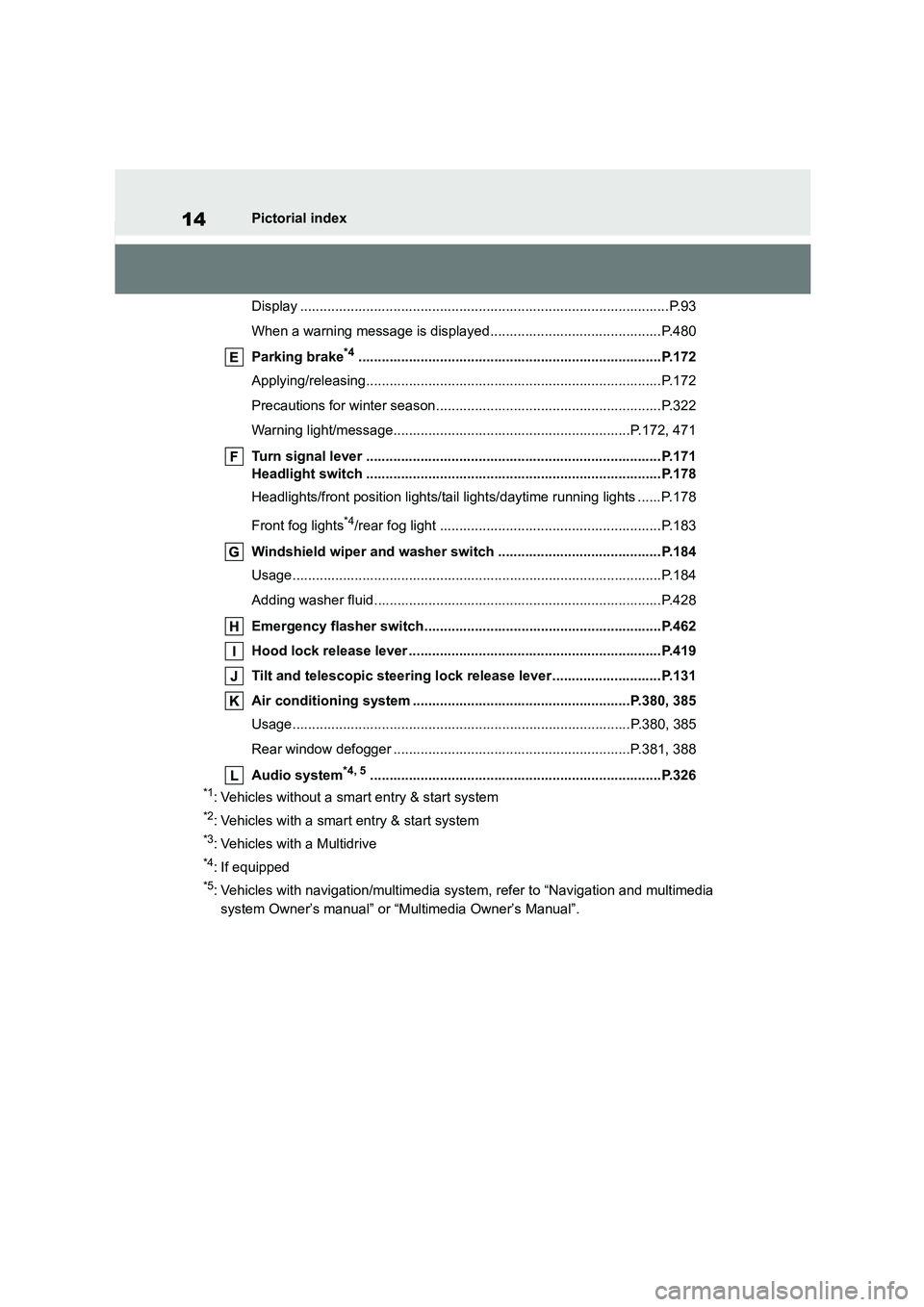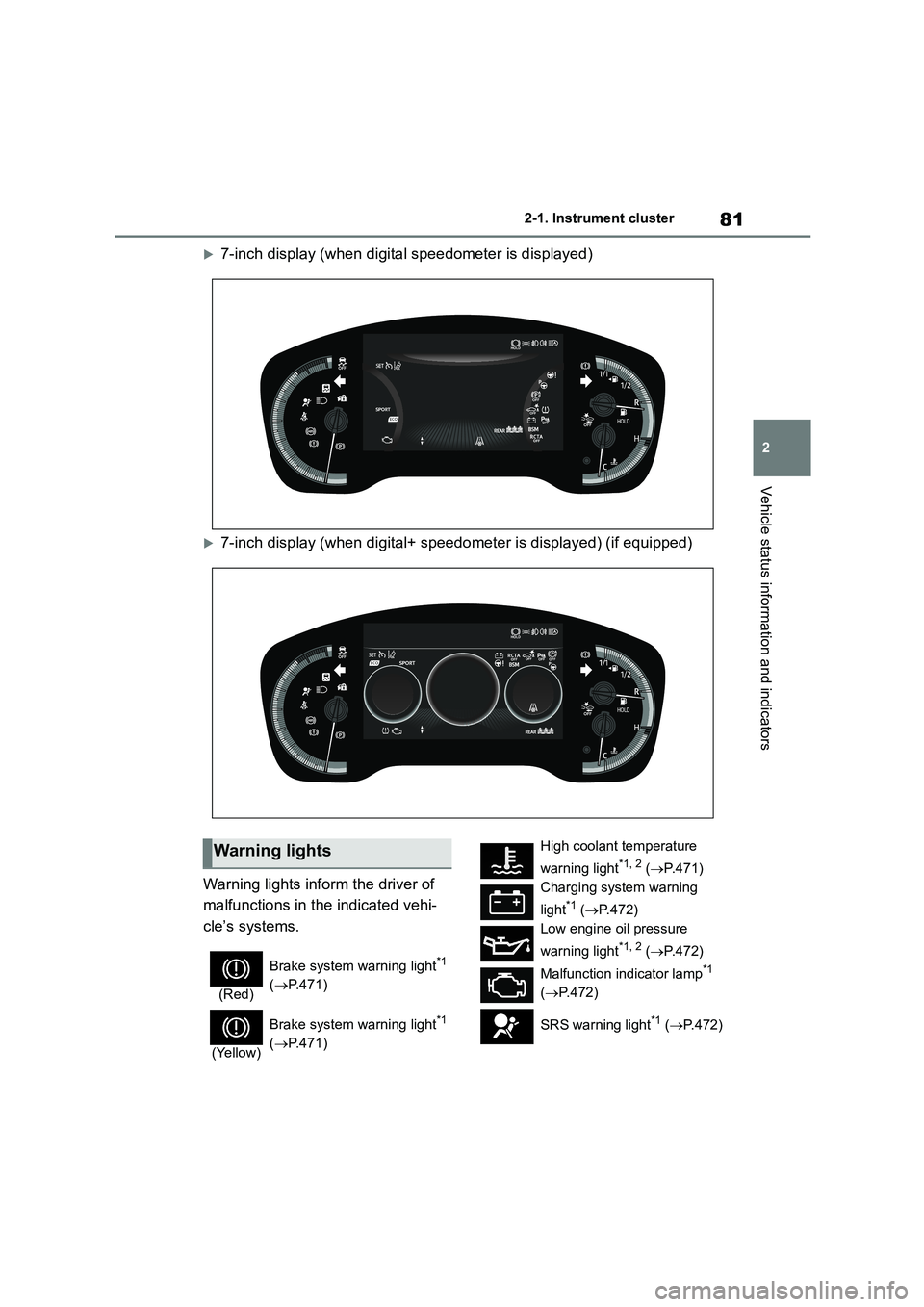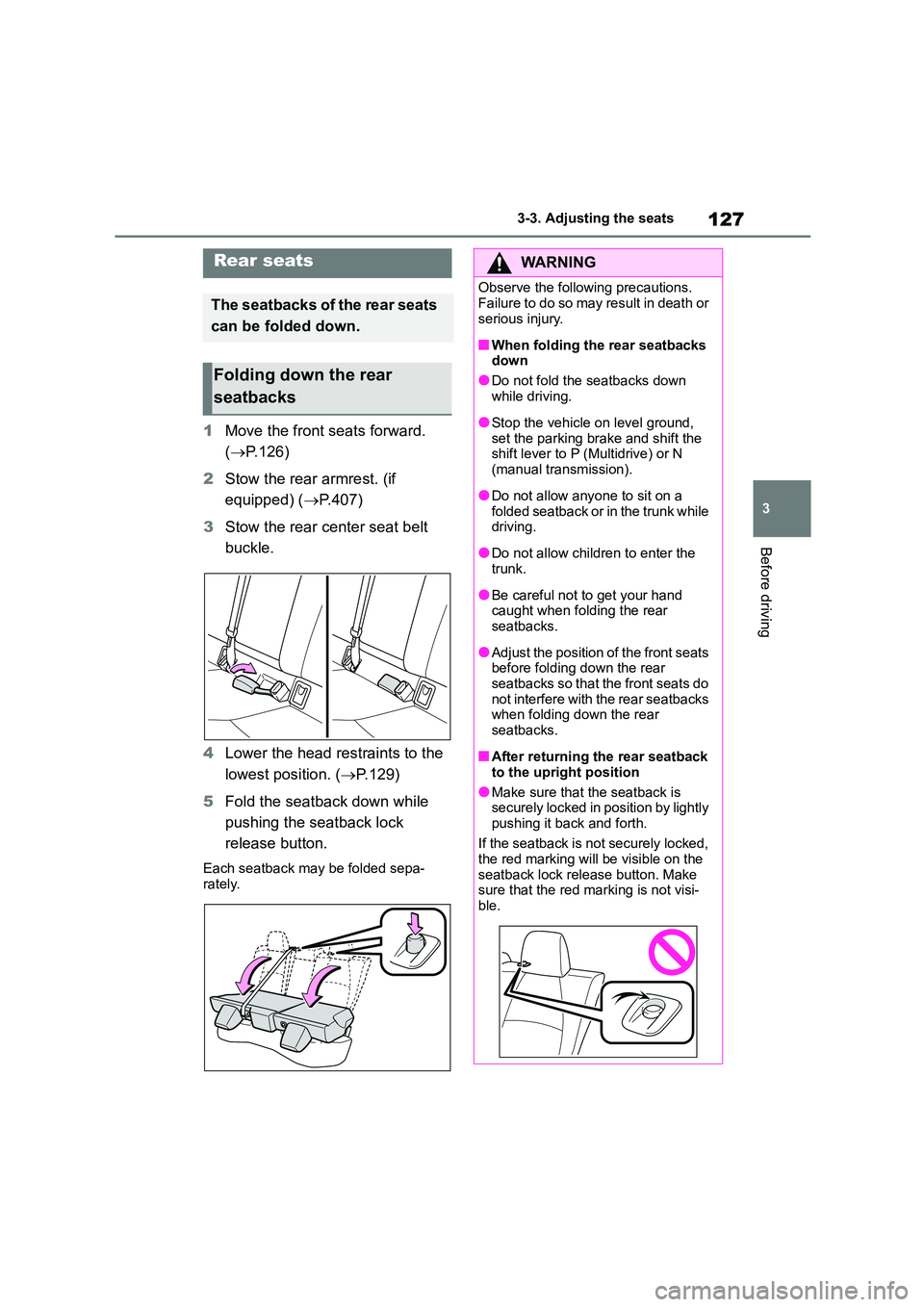2022 TOYOTA COROLLA brake light
[x] Cancel search: brake lightPage 5 of 678

3TABLE OF CONTENTS
1
6
5
4
3
2
9
8
7
4-2. Driving procedures
Engine (ignition) switch (vehicles
without a smart entry & start
system) ............................. 159
Engine (ignition) switch (vehicles
with a smart entry & start sys-
tem) .................................. 160
Multidrive ............................ 165
Manual transmission ........... 169
Turn signal lever ................. 171
Parking brake...................... 172
Electric parking brake ......... 173
Brake Hold .......................... 176
4-3. Operating the lights and wip-
ers
Headlight switch.................. 178
AHB (Automatic High Beam)
.......................................... 181
Fog light switch ................... 183
Windshield wipers and washer
.......................................... 184
4-4. Refueling
Opening the fuel tank cap ... 188
4-5. Using the driving support sys-
tems
Toyota Safety Sense ........... 190
PCS (Pre-Collision System)
.......................................... 202
LTA (Lane Tracing Assist) ... 209
LDA (Lane Departure Alert with
steering control) ................ 219
Dynamic radar cruise control
with full-speed range ........ 227
Dynamic radar cruise control
.......................................... 238
Cruise control...................... 249
Speed limiter ....................... 252
RSA (Road Sign Assist) ...... 254
BSM (Blind Spot Monitor) ... 258
Toyota parking assist-sensor
.......................................... 263
RCTA (Rear Crossing Traffic
Alert) function ................... 271
PKSB (Parking Support Brake)
.......................................... 276
Parking Support Brake function
(static objects) .................. 283
Parking Support Brake function
(rear-crossing vehicles) .... 286
S-IPA (Simple Intelligent Parking
Assist System) .................. 288
Driving mode select switch
.......................................... 314
GPF (Gasoline Particulate Filter)
system .............................. 315
Driving assist systems ........ 316
4-6. Driving tips
Winter driving tips ............... 321
5-1. Basic Operations
Audio system types............. 326
Using the steering wheel audio
switches ............................ 327
USB port ............................. 328
5-2. Using the audio system
Optimal use of the audio system
.......................................... 329
5-3. Using the radio
Radio operation .................. 331
5-4. Playing an audio CD and
MP3/WMA discs
CD player operation ............ 333
5-5. Using an external device
Listening to an iPod ............ 339
5Audio system
Page 16 of 678

14Pictorial index
Display ...............................................................................................P.93
When a warning message is displayed............................................P.480
Parking brake*4..............................................................................P.172
Applying/releasing............................................................................P.172
Precautions for winter season..........................................................P.322
Warning light/message.............................................................P.172, 471
Turn signal lever ............................................................................P.171
Headlight switch ............................................................................P.178
Headlights/front position lights/tail lights/daytime running lights ......P.178
Front fog lights*4/rear fog light .........................................................P.183
Windshield wiper and washer switch ..........................................P.184
Usage...............................................................................................P.184
Adding washer fluid..........................................................................P.428
Emergency flasher switch.............................................................P.462
Hood lock release lever .................................................................P.419
Tilt and telescopic steering lock release lever ............................P.131
Air conditioning system ........................................................P.380, 385
Usage.......................................................................................P.380, 385
Rear window defogger .............................................................P.381, 388
Audio system*4, 5...........................................................................P.326
*1: Vehicles without a smart entry & start system
*2: Vehicles with a smart entry & start system
*3: Vehicles with a Multidrive
*4: If equipped
*5: Vehicles with navigation/mu ltimedia system, refer to “Navigation and multimedia
system Owner’s manual” or “Multimedia Owner’s Manual”.
Page 39 of 678

37
1
1-1. For safe use
For safety and security
may be sustained from SRS airbags,
due to the extremely high speed deployment (inflation) by hot gases.
●A loud noise and white powder will be emitted.
●Parts of the airbag module (steering wheel hub, airbag cover and inflator)
as well as the front seats, parts of the
front and rear pillars, and roof side rails, may be hot for several minutes.
The airbag itself may also be hot.
●The windshield may crack.
●The brakes and stop lights will be con- trolled automatically. ( P.316)
●The interior lights will turn on automat- ically. ( P.395)
●The emergency flashers will turned on automatically. ( P.462)
●Fuel supply to the engine will be stopped. ( P.470)
●Vehicles with eCall: If any of the fol-
lowing situations occur, the system is
designed to send an emergency call*
to the eCall control center, notifying
them of the vehicle’s location (without needing to push the “SOS” button)
and an agent will attempt to speak
with the occupants to ascertain the level of emergency and assistance
required. If the occupants are unable
to communicate, the agent automati- cally treats the call as an emergency
and helps to dispatch the necessary
emergency services. ( P. 6 4 ) • An SRS airbag is deployed.
• A seat belt pretensioner is activated.
• The vehicle is involved in a severe rear-end collision.*: In some cases, the call cannot be
made. ( P. 6 5 )
■SRS airbag deployment conditions (SRS front airbags)
●The SRS front airbags will deploy in the event of an impact that exceeds
the set threshold le vel (the level of
force corresponding to an approxi- mately 20 - 30 km/h [12 - 18 mph]
frontal collision with a fixed wall that
does not move or deform).
However, this threshold velocity will be
considerably higher in the following situ-
ations: • If the vehicle strikes an object, such
as a parked vehicle or sign pole,
which can move or deform on impact • If the vehicle is involved in an
underride collision, such as a collision
in which the front of the vehicle “underrides”, or goes under, the bed
of a truck
●Depending on the type of collision, it is
possible that only the seat belt
pretensioners will activate.
■SRS airbag deployment conditions (SRS side and curtain shield
airbags [if equipped])
●The SRS side and curtain shield
airbags will deploy in the event of an
impact that exceeds the set threshold level (the level of force corresponding
to the impact force produced by an
approximately 1500 kg [3300 lb.] vehi- cle colliding with the vehicle cabin
from a direction perpendicular to the
vehicle orientation at an approximate speed of 20 - 30 km/h [12 - 18 mph]).
●Vehicles with an SRS driver’s knee airbag: Both SRS curtain shield
airbags may deploy in the event of a
severe side collision.
●Both SRS curtain shield airbags may
also deploy in the event of a severe frontal collision.
■Conditions under which the SRS
airbags may deploy (inflate), other
than a collision
The SRS front airbags and SRS side
and curtain shield airbags may also
deploy if a serious impact occurs to the
underside of your vehicle. Some exam- ples are shown in the illustration.
●Hitting a curb, edge of pavement or hard surface
●Falling into or jumping over a deep hole
●Landing hard or falling
Page 83 of 678

81
2
2-1. Instrument cluster
Vehicle status information and indicators
7-inch display (when digital speedometer is displayed)
7-inch display (when digital+ speedometer is displayed) (if equipped)
Warning lights inform the driver of
malfunctions in the indicated vehi-
cle’s systems.
Warning lights
(Red)
Brake system warning light*1
( P.471)
(Yellow)
Brake system warning light*1
( P.471)
High coolant temperature
warning light*1, 2 ( P.471)
Charging system warning
light*1 ( P.472)
Low engine oil pressure
warning light*1, 2 ( P.472)
Malfunction indicator lamp*1
( P.472)
SRS warning light*1 ( P.472)
Page 84 of 678

822-1. Instrument cluster
*1: These lights come on when the
engine switch is turned to ON to indi-
cate that a system check is being
performed. They will turn off after the
engine is started, or after a few sec-
onds. There may be a malfunction in
a system if the lights do not come
on, or turn off. Have the vehicle
inspected by any authorized Toyota
retailer or Toyota authorized repairer,
or any reliable repairer.
*2: As these lights are displayed on the
multi-information display, they will
not turn on when a system check, as
described in*1 above, is being per-
formed.
*3: This light illuminates on the
multi-information display.
ABS warning light*1 ( P.473)
Brake Override System warn-
ing light/Drive-S tart Control
warning light*3 ( P.473)
(Red)
Electric power steering sys-
tem warning light*1 ( P.474)
(Yellow)
Electric power steering sys-
tem warning light*1 ( P.474)
Low fuel level warning light
( P.474)
Driver’s and front passen-
ger’s seat belt reminder light
( P.474)
Rear passengers’ seat
belt reminder lights (if
equipped) ( P.474)
Low windshield washer fluid
warning light*1 (if equipped)
( P.475)
Tire pressure warning light*1
( P.475)
(Orange)
LTA indicator (if equipped)
( P.475)
LDA indicator (if equipped)
( P.475)
(Flashes)
Toyota parking assist-sensor
OFF indicator*1 (if equipped)
( P.476)
(Flashes)
RCTA OFF indicator*1 (if
equipped) ( P.476)
(Flashes)
PKSB OFF indicator*1 (if
equipped) ( P.476)
(Flashes or illumi-nates)
PCS warning light*1 (if
equipped) ( P.477)
(Yellow)
Cruise control indicator (if
equipped) ( P.477)
Slip indicator*1 ( P.477)
(Flashes)
Parking brake indicator
( P.478)
(Flashes)
Brake hold operated indica-
tor*1 (if equipped) ( P.478)
Page 85 of 678

83
2
2-1. Instrument cluster
Vehicle status information and indicators
The indicators inform the driver of
the operating state of the vehicle’s
various systems.
WA R N I N G
■If a safety system warning light
does not come on
Should a safety system light such as the ABS and SRS warning light not
come on when you start the engine,
this could mean that these systems are not available to help protect you in
an accident, which could result in
death or serious injury. Have the vehi-
cle inspected by any authorized Toyota retailer or Toyota authorized
repairer, or any reliable repairer
immediately if this occurs.
Indicators
Turn signal indicator
( P.171)
Tail light indicator ( P.178)
Headlight high beam indica-
tor ( P.179)
Automatic High Beam indica-
tor (if equipped) ( P.181)
Front fog light indicator (if
equipped) ( P.183)
Rear fog light indicator
( P.183)
PCS warning light*1, 2 (if
equipped) ( P.204)
Cruise control indicator (if
equipped) ( P.227, 238,
249)
Dynamic radar cruise control
indicator (if equipped)
( P.227, 238)
Cruise control “SET” indica-
tor (if equipped) ( P.227,
238, 249)
*3
LTA indicator (if equipped)
( P.214)
LDA indicator (if equipped)
( P.223)
BSM outside rear view mirror
indicators*1, 4 (if equipped)
( P.259)
BSM indicator (if equipped)
( P.259)
Toyota parking assist-sensor
OFF indicator*1, 2 (if
equipped) ( P.264)
RCTA OFF indicator*1, 2 (if
equipped) ( P.272)
PKSB OFF indicator*1, 2 (if
equipped) ( P.277)
Speed limiter indicator (if
equipped) ( P.252)
S-IPA indicator*1 (if
equipped) ( P.288)
(Flashes)
Slip indicator*1 ( P.317)
VSC OFF indicator*1, 2
( P.317)
Smart entry & start system
indicator*5 (if equipped)
( P.160)
Gear Shift Indicator (if
equipped) ( P.170)
Parking brake indicator
( P.172, 173)
Brake hold standby indica-
tor*1 (if equipped) ( P.176)
Brake hold operated indica-
tor*1 (if equipped) ( P.176)
Page 129 of 678

127
3
3-3. Adjusting the seats
Before driving
1 Move the front seats forward.
( P.126)
2 Stow the rear armrest. (if
equipped) ( P.407)
3 Stow the rear center seat belt
buckle.
4 Lower the head restraints to the
lowest position. ( P.129)
5 Fold the seatback down while
pushing the seatback lock
release button.
Each seatback may be folded sepa- rately.
Rear seats
The seatbacks of the rear seats
can be folded down.
Folding down the rear
seatbacks
WA R N I N G
Observe the following precautions.
Failure to do so may result in death or
serious injury.
■When folding the rear seatbacks
down
●Do not fold the seatbacks down
while driving.
●Stop the vehicle on level ground, set the parking brake and shift the
shift lever to P (Multidrive) or N
(manual transmission).
●Do not allow anyone to sit on a
folded seatback or in the trunk while driving.
●Do not allow children to enter the trunk.
●Be careful not to get your hand caught when folding the rear
seatbacks.
●Adjust the position of the front seats
before folding down the rear
seatbacks so that the front seats do not interfere with the rear seatbacks
when folding down the rear
seatbacks.
■After returning the rear seatback
to the upright position
●Make sure that the seatback is
securely locked in position by lightly
pushing it back and forth.
If the seatback is not securely locked,
the red marking will be visible on the
seatback lock releas e button. Make sure that the red marking is not visi-
ble.
Page 145 of 678

4
143
4
Driving
Driving
.4-1. Before driving
Driving the vehicle ............ 145
Cargo and luggage ........... 152
Trailer towing (for M15A-FKS
engine) ........................... 153
Trailer towing (except for
M15A-FKS engine) ......... 158
4-2. Driving procedures
Engine (ignition) switch (vehi-
cles without a smart entry &
start system) ................... 159
Engine (ignition) switch (vehi-
cles with a smart entry & start
system) ........................... 160
Multidrive .......................... 165
Manual transmission ......... 169
Turn signal lever ............... 171
Parking brake ................... 172
Electric parking brake ....... 173
Brake Hold ........................ 176
4-3. Operating the lights and wip-
ers
Headlight switch ............... 178
AHB (Automatic High Beam)
....................................... 181
Fog light switch ................. 183
Windshield wipers and washer
....................................... 184
4-4. Refueling
Opening the fuel tank cap
....................................... 188
4-5. Using the driving support
systems
Toyota Safety Sense ......... 190
PCS (Pre-Collision System)
........................................ 202
LTA (Lane Tracing Assist)
........................................ 209
LDA (Lane Departure Alert with
steering control) .............. 219
Dynamic radar cruise control
with full-speed range ...... 227
Dynamic radar cruise control
........................................ 238
Cruise control.................... 249
Speed limiter ..................... 252
RSA (Road Sign Assist) .... 254
BSM (Blind Spot Monitor)
........................................ 258
Toyota parking assist-sensor
........................................ 263
RCTA (Rear Crossing Traffic
Alert) function ................. 271
PKSB (Parking Support Brake)
........................................ 276
Parking Support Brake function
(static objects) ................ 283
Parking Support Brake function
(rear-crossing vehicles) .. 286
S-IPA (Simple Intelligent Park-
ing Assist System) .......... 288
Driving mode select switch
........................................ 314
GPF (Gasoline Particulate Fil-
ter) system ...................... 315